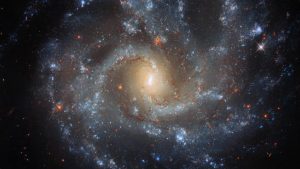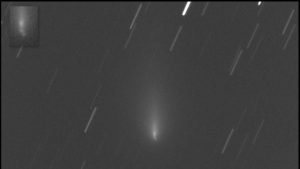
Researchers from Instituto de Astrofísica e Ciências do Espaço have obtained important results about the central spherical component (the bulge) in spiral galaxies like the Milky Way, shedding new light on our understanding of galactic evolution. C/2019 Y4 ATLAS was supposed to be the brightest comet to decorate the night sky in decades, but now it appears to have suffered a major collapse. Finally, we have guests Deborah Domingue Lorin and Jeffrey Kargel from PSI to talk Mercury.
Links
Researchers have obtained important results about the central spherical component in spiral galaxies like the Milky Way
Comet Atlas has fragmented into pieces
- The fragmentation of comet C/2019 Y4 (Atlas) observed at Lulin observatory (Astronomer’s Telegram)
- Oh Crap, a Really Promising Comet Just Fell to Pieces (Gizmodo)
Interview with Deborah Domingue Lorin and Jeffrey Kargel from Planetary Science Institute
- The Chaotic Terrains of Mercury Reveal a History of Planetary Volatile Retention and Loss in the Innermost Solar System (Scientific Reports)
Transcript
This is the Daily Space for today, Tuesday, April 14, 2020.
Welcome to the Daily Space, I am your host, Dr Pamela Gay, and I am here to put science in your brain. Most Mondays through Fridays either I or my co-host Annie Wilson will be here, bringing you a quick run down of all that is new in space and astronomy.
Sometimes astronomy giveth, and sometimes it takes away. Today we have both, times two.

In our first story, the Instituto de Astrofisica e Ciencias de Espaco has announced that scientists using the Integral Field Spectroscopy have studied the central bulges of spiral galaxies to understand the factors that cause the bulges to grow. Over several years, they computationally chewed through approximately 500,000 spectra that covered all possible variations on “non-interacting spiral galaxies.” By looking at every combination of disk, bulge, and arms, they hoped to identify what physical characteristics are linked together. With this data, the team was able to measure, among other things, how stellar ages vary across the galactic bulge as a function of kind of galaxy
Like many things now being determined with data, these results run counter to what we would have expected a few years ago. Specifically, they found that in low mass galaxies, stars go from young to old as you move out from the center, while in high mass galaxies, stars run from old to young as you move out. Yes folks, the distribution of stars by age varies with mass. This happens even though the galaxies themselves appear to form in the same manner, through aggregation of smaller systems. These differences may be related to past active galactic nuclei (AGN) in these bulges that blasted out radiation and cleared the core while pushing material to outer areas.
Overall, they find the process of growing galaxy bulges is a slow and gradual process with bulges forming over 2 to 4 billion years, and an AGN defines a flipping point where the galactic core goes from densest in the core with star formation, to empty in the core due to light pressure.
This work should allow detailed models to be created that allow us to step through the process of bulge formation by looking at systems of every intermittent age and size. This is just cool and straight forward research that becomes complex in the computational power required to make this result possible. These results are reported in Astronomy and Astrophysics and was led by Iris Breda.
This is the case of the universe giveth. The first case at least. Now for the universe taking away.

CREDIT: The Virtual Telescope Project 2.0/Gianluca Masi
We can confirm that Comet Atlas has totally fallen to pieces. In an Astronomer’s Telegram, astronomers Zhong-Yi Lin and collaborators report that in observations taken with the Lulin 40cm telescope, they see a nucleus and 2 additional fragments trailing 3400 and 5000 km from the core. She’s dead, Jim. No bright comet for us.
Now, those are our new news stories for today. In a moment, 2 special guests will be joining us to discuss results from 2 weeks ago. In a remarkable paper in the Journal Nature, they described how Mercury may have held onto the kinds of volatile gases required for life all the way up to 1.8 billion years ago. In the deep hollows of the chaotic Terrain, the broken landscape opposite the Caloris impact basin may – may – have once been capable of supporting life ever so briefly. If this is the case, relectics of prebiotic chemistry may be waiting to be discovered by future Mercurial Rovers… that no one is planning to build. Volatiles gave the potential for life, and the heat of the Sun baked that potential away.
We’re going to pause for a moment to bring on our guests. Don’t go anywhere, when we return, we’ll be joined by Drs. Deborah Domingue Lorin and Jeffrey Kargel of the Planetary Science Institute. As a reminder, the Daily Space is a product of the Planetary Science Institute. Stay tuned.
<———————>
As part of helping keep us all occupied in these really weird times, we’re going to be hosting a lot of additional content on our Twitch channel, and we want to remind you that CosmoQuest has an active community on Discord where you can talk science, volunteer for various projects, and even find other people to join you in playing some online games. You can find links to everything that is going on at CosmoQuest.org.
Thank you all for listening. Today’s script was written by Pamela Gay, and the Daily Space is produced by Susie Murph. The Daily Space is a product of the Planetary Science Institute, a 501(c)3 non profit dedicated to exploring our Solar System and beyond. We are here thanks to the generous contributions of people like you. The best way you can support us is through Patreon.com/cosmoquestx Like us? Please share us! You never know whose life you can change by adding a daily dose of science.


 We record most shows live, on Twitch. Follow us today to get alerts when we go live.
We record most shows live, on Twitch. Follow us today to get alerts when we go live.